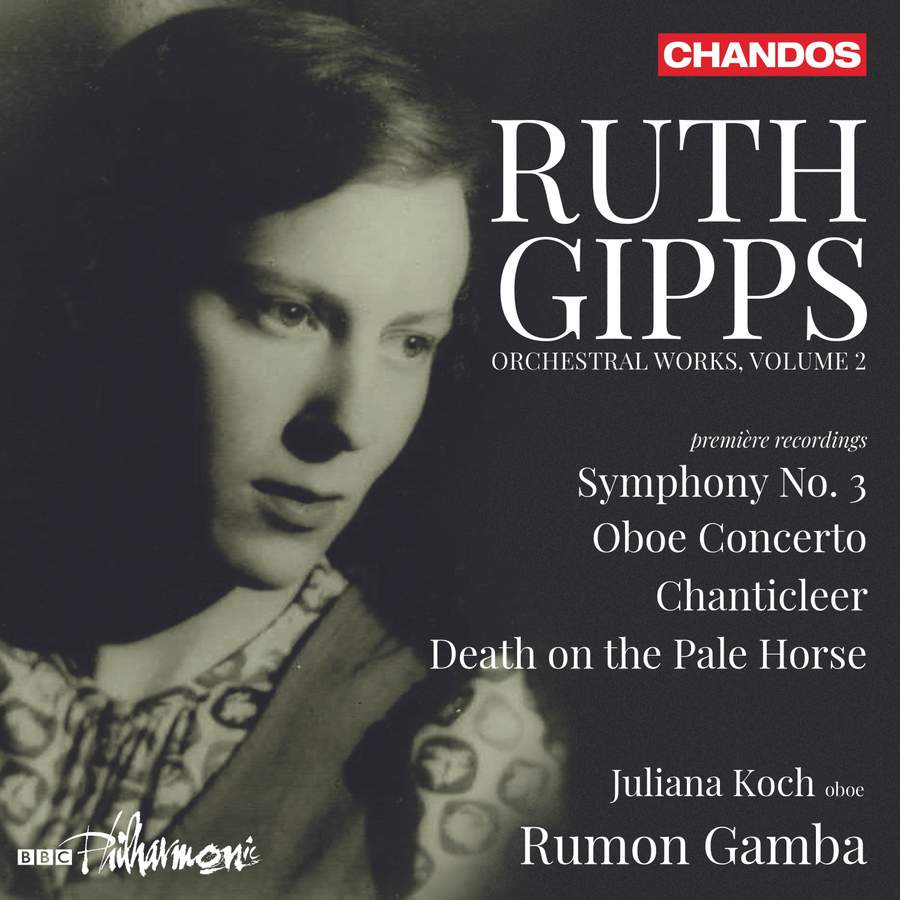GIPPS Orchestral Works (Gamba)
View record and artist detailsRecord and Artist Details
Genre:
Orchestral
Label: Chandos
Magazine Review Date: 12/2022
Media Format: CD or Download
Media Runtime: 76
Mastering:
DDD
Catalogue Number: CHAN20161

Tracks:
| Composition | Artist Credit |
|---|---|
| Chanticleer Overture |
Ruth Gipps, Composer
BBC Philharmonic Orchestra Rumon Gamba, Conductor |
| Oboe Concerto |
Ruth Gipps, Composer
BBC Philharmonic Orchestra Rumon Gamba, Conductor |
| Death on the Pale Horse |
Ruth Gipps, Composer
BBC Philharmonic Orchestra Rumon Gamba, Conductor |
| Symphony No 3 |
Ruth Gipps, Composer
BBC Philharmonic Orchestra Rumon Gamba, Conductor |
Author: Guy Rickards
Although as a pianist she was virtuoso enough to play concertos by Brahms and Glazunov, the oboe was Ruth Gipps’s instrument. It was inevitable that she should pen a concerto for it, surprisingly early in her career, in 1941. It was written for her close friend Marion Brough, who duly premiered it in London the following year. Its three movements (fast-slow-faster) are beautifully laid out for the oboe and its small accompanying orchestra (double woodwind – but no oboes – two horns, trumpet and strings). Juliana Koch, principal oboe of the London Symphony Orchestra, is an apposite choice for soloist being Professor of Oboe at London’s Royal College of Music, where Gipps studied under the great Leon Goossens in the 1930s. Koch certainly has the measure of the notes but catches the warmth of expression lying between them, particularly in the brief central Andante, where she alternates with a solo clarinet (the instrument of Gipps’s husband). It is a lovely addition to the repertoire.
The overture Chanticleer is the sole fully orchestrated part from Gipps’s abandoned opera (Act 1 exists in short score), based on Edmond Rostand’s play, inspired by the French countryside (not Chaucer). To my ears there is little overt in Gipps’s music of the farmyard or, indeed, France. It is, nonetheless, highly engaging and superbly orchestrated, as is Death on the Pale Horse (1943), an evocative wartime ‘symphonic impression’ inspired by Blake’s painting. Given its subject (one of the Four Horsemen of the Apocalypse), the tone is elegiac rather than biblical, perhaps reflecting Gipps’s feelings about the Second World War.
Her large-scale Third Symphony (1965) is rather later, and one needs to say either a lot, or a little, about it. Let it suffice, then, to point up the four movements’ lucid structure (sonata form – theme and variations – scherzo and trio – fugal finale) and limpid, ear-catching orchestration. (Well, she was a pupil of Gordon Jacob!) For all the resonances of Vaughan Williams, Holst and others, Gipps was her own woman with her own distinct voice. The BBC Philharmonic sound as though they relished communing with the music throughout, and Chandos’s sound is first-rate. Warmly recommended.
Discover the world's largest classical music catalogue with Presto Music.

Gramophone Digital Club
- Digital Edition
- Digital Archive
- Reviews Database
- Full website access
From £8.75 / month
Subscribe
Gramophone Full Club
- Print Edition
- Digital Edition
- Digital Archive
- Reviews Database
- Full website access
From £11.00 / month
Subscribe
If you are a library, university or other organisation that would be interested in an institutional subscription to Gramophone please click here for further information.




